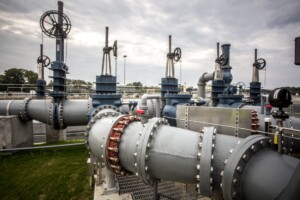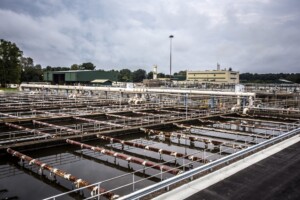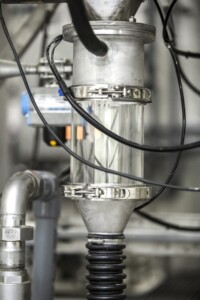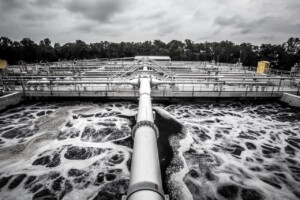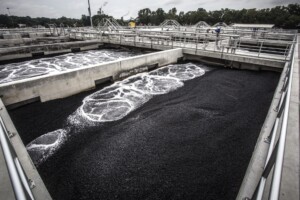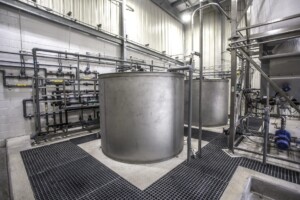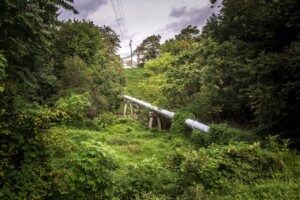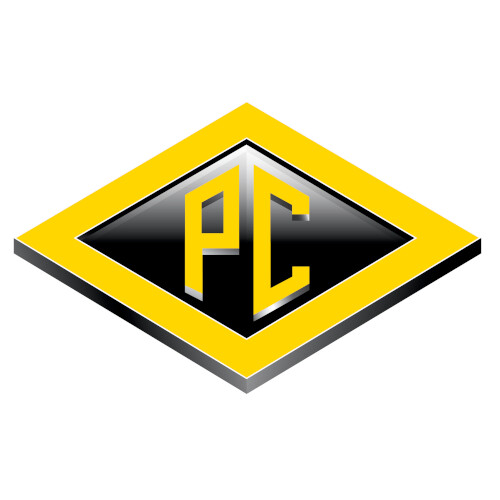Challenge
The Hopewell Water Renewal Facility is a unique 50 mgd publicly owned treatment facility serving 23,000 customers, with 85% of influent from industrially sourced wastewater—posing a distinct treatment challenge. Without cost-effective treatment, nitrogen would be discharged to the James River, a tributary to the nationally treasured Chesapeake Bay, at higher loads than the new regulatory requirements allow. Other challenges included high influent temperatures, variable influent characteristics, frequent spike loading, and high concentrations of volatile organic compounds. This was unacceptable to the residents of Hopewell and the ecology of the Chesapeake Bay.
Under Virginia’s Public-Private Education Facilities and Infrastructure Act of 2002 (PPEA), Hopewell Nutrient Partners developed an unsolicited design-build proposal for solving Hopewell’s industrial-sized wastewater challenges. The PPEA allows municipalities to accept unsolicited proposals and enter into a single contract for design and construction. Before entering into the contract, the City developed detailed review guidelines and provided an opportunity for competing proposals. The primary reasons the City chose design-build delivery were their ability to select the treatment technology (MBBR+DAF) and cost certainty.
The City pilot tested the MBBR+DAF system and found it more reliable than conventional technologies. The City and its funding partners set a maximum price on the project and Hopewell Nutrient Partners committed to that cost.
As a result, lump-sum design-build delivery was the most practical way to meet the financial needs of the City and its funding partners and to complete the project in the most economical fashion. The unsolicited proposal included an advanced design concept due to the joint venture partners’ familiarity with the plant. A design-bid-build approach would have extended the planning and design phases, preventing construction from starting until a typically lengthy public procurement process had been done.
Approach
Extensive performance testing proved that the project reduced the quantity of nitrogen discharged to below regulatory requirements. It also improved control of high influent temperatures, variable influent characteristics, frequent spike loading, and volatile organic compounds. Hopewell Nutrient Partners signed teaming agreements with key equipment suppliers that provided the innovative moving bed biofilm reactor and dissolved air flotation (MBBR+DAF) treatment process to conquer the main challenge of nitrogen reduction. Segregating industrial flows allows reduction in high temperatures, variable and spike loads, and VOCs, then flows are integrated under more stable conditions for secondary treatment. The project also provided additional capacity to support the growing $1.6 billion regional manufacturing industry through the year 2040.
Results
The Phase 2 improvements provide additional treatment capacity needed by the manufacturing industry, which employs nearly 5,000 people and provides $1.6 billion in economic output to the city and surrounding communities. This project and the delivery model combined the resources and support of local government, industry, and the citizens. The team’s leadership and vision allowed the city to achieve significant nitrogen reduction at the lowest possible cost. By partnering with the city and using design-build delivery, the project finished six weeks earlier than planned and, through an extensive value engineering process, saved $14 million from the original budget. Removing more than 500,000 pounds of nitrogen from the river annually is a daunting task. Doing so for less than $4 per pound is a true indication of the efficiency of our installed system; similar facilities have nitrogen removal costs up to $80 per pound!
This project will also reduce chlorine use by disinfecting segregated effluent instead of primary effluent—saving nearly $500,000 annually from day one, which will grow to nearly $1 million annual savings by 2040. The inherent collaboration in the design-build approach resulted in innovations that would not be available through other delivery models. The pump systems were sized to provide the most efficient arrangement for quantity and speed to efficiently meet performance requirements and reduce operational cost.
Additionally, we combined two blower types to balance costs with maximum efficiency. Only seven owner-directed changes were issued, accounting for less than 2% of original contract amount and not impacting the project completion date. Our DB project delivery team evaluated the existing system, and then, with the City and its funding partners, developed plans to install sustainable new technology to upgrade treatment processes. The final scope included 15 definable features of work—proficiently engineered, expertly constructed, and skillfully commissioned on the first run—producing a positive image for the stakeholders. From the public’s perspective, the most visible improvement is the exceptional water quality entering the James River and Chesapeake Bay for decades to come.
“[We] greatly appreciated the team’s efforts and their open and collegial attitude, and [we are] certain the success of this project was founded on their collaborative attitudes and methods.”
—Steven D. Raney, Project Officer, Clean Water Financing & Assistance Program Virginia Department of Environmental Quality

